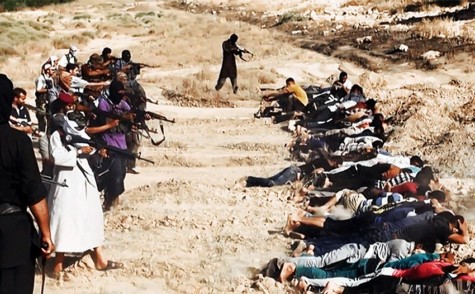Balsam Awni writes for EA, in partnership with The Conversation:
As the world marks a year since the Islamic State captured Iraq’s second city, Mosul, one of the most devastating events from the group’s June 2014 offensive is still buried under myth and misinformation.
On June 12, 2014, three days after Mosul fell, the Islamic State disseminated images via social media of a mass killing of Shia Muslim soldiers in Iraq’s army. The mass killing was carried outside the Iraqi base at Camp Speicher near Tikrit, 130 km (80 miles) north of Baghdad.
IS circulated about 60 pictures with captions on the same day of the massacre, via its now-blocked Twitter account Wilayat Salah al-Din and on a Poland-based website called JustPaste. The pictures showed masked IS fighters loading the captured victims in civilian clothes onto trucks, then shooting them in a field near Saddam Hussein’s old palaces.
On the same day, two separate videos and voiceovers were uploaded to YouTube by an IS supporter called Omar al-Farouq, showing the victims on a forced march in the street. On June 14, IS campaign disseminated a slideshow video of the images.
According to Iraqi officials and Human Rights Watch’s officers, the images could not be immediately verified as authentics. Some officials in Baghdad denied the incident altogether.
But at the end of July, IS uploaded another YouTube video, confirming the execution and showing a new killing field on the Tigris River in addition to the previous site. By that time, stunned and shocked, the families of the victims were protesting in the streets of Baghdad and other cities in the south, demanding answers from Iraqi officials.
From Scattered Images to Organized PR
Some claimed that IS had established a well-organized and well-coordinated media machine immediately following the capture of Mosul, but the Speicher episode offered a far different reality.
Shocking and intimidating, the images and tweets generated an unstructured narrative that was open to various interpretations. With no further supporting religious justification, the images and captions were like unmatched puzzle piece. They offered elements of a story in the ethnic, religious, and the socio-political but they did not establish a coherent narrative.
The ethnic approach of the images labelled the victims as “Safavid” or “Persians”, thus denying they were Arabs and and linking them to Iran. The religious element was promoted through the use of the word “Rawafith”, describing the hostages as non-Muslims. The socio-political element was evident in the highlighting of Sunni-Shia division, as captions asserted that only Shia soldiers were executed in revenge for an IS leader killed by Iraqi forces during early 2014. The 2014 video went farther, saying that all Shia deserved such a fate
That particular message can be traced back to anti-government protests in Anbar Province in western Iraq from 2012, with IS opposing not only Shia and other ethnicities but also Sunnis who don’t support the group.
However, the militants did not follow up the images and video with a story of what actually happened at Speicher – and that left a gap for Western news agencies to fill.
Enter the Western Media
Faced with an apparent atrocity that they could not poinpoint or fully account for, news agencies tried to use eyewitnesses to identify the location where the victims were captured. But even this caused problems: the misinterpretation spread that the base had actually fallen to the Islamic State — and in the absence of a clear narrative, extraneous information was sucked in to explain what happened.
Referring to Speicher as “a former US military base”, The New York Times and the Daily Telegraph wedged the incident into a narrative taking in the 2003 American invasion of Iraq and its aftermath – implicitly framing the events of 2014 as a continuation of the chaos of a decade earlier and thereby badly misrepresenting IS’s motives.
Meanwhile, linking IS’s captions of Shia-Sunni division to the civil war of 2006-07 in Iraq fed a narrative of sectarian tension and the predictions of worse to come, as in the Independent’s emphasis of “revenge” on Shia. And by depicting the victims as soldiers who “fled” or “surrendered”, as the BBC and New York Times did, the blame for the deaths began to fall both on the “cowardice” of troops and the Iraqi political leadership.
Victims Erased
In September, the atrocity was lifted a bit above the myths with the first-hand accounts of survivors. This spring, after Iraqi forces and Shia militias reclaimed Tikrit and surrounding areas, mass graves were excavated and bodies exhumed.
By then, however, any reality of Speicher had been buried under subsequent narratives. The Islamic State established its professional media operations for productions around beheadings and destruction of artefacts. Western media did not have to fill a space but could amplify IS’s message as one of brutality and extremism, while at the same time continuing its blame of disfunctional Iraqi Government and armed forces. Shia v. Sunni had been entrenched as a default description of Iraqi society.
And this week, even if Speicher is invoked, the victims are erased. In the headline of the International Business Times, the mass killings become “Five US Mistakes Which Led to the Rise of Islamic State“.

